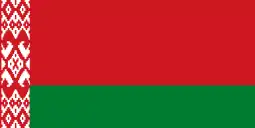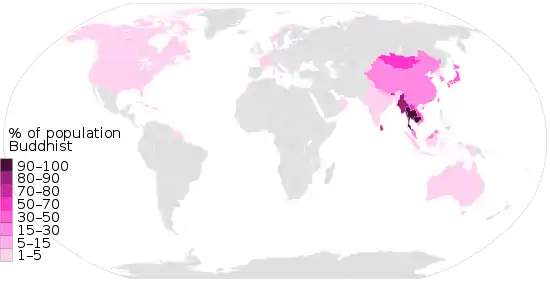List of religious populations
Adherents in 2020
| Religion | Adherents | Percentage |
|---|---|---|
| Christianity | 2.382 billion | 31.11%[3][2] |
| Islam | 1.907 billion | 24.9%[2][3] |
| Secular[lower-alpha 1]/Nonreligious[lower-alpha 2]/Agnostic/Atheist | 1.193 billion | 15.58% |
| Hinduism | 1.161 billion | 15.16%[2][3] |
| Buddhism | 506 million | 5.06%[2][3] |
| Chinese traditional religion[lower-alpha 3] | 394 million | 5% |
| Ethnic religions excluding some in separate categories | 300 million | 3% |
| African traditional religions | 100 million[6] | 1.2% |
| Sikhism | 26 million | 0.30% |
| Spiritism | 15 million | 0.19% |
| Judaism | 14.7 million[7] | 0.18% |
| Baháʼí | 5.0 million[8] | 0.07% |
| Jainism | 4.2 million | 0.05% |
| Shinto | 4.0 million | 0.05% |
| Cao Dai | 4.0 million | 0.05% |
| Zoroastrianism | 2.6 million | 0.03% |
| Tenrikyo | 2.0 million | 0.02% |
| Animism | 1.9 million | 0.02% |
| Neo-Paganism | 1.0 million | 0.01% |
| Unitarian Universalism | 0.8 million | 0.01% |
| Rastafari | 0.6 million | 0.007% |
| total | 7.79 billion | 100% |
Notes
- These figures may incorporate populations of secular/nominal adherents as well as syncretist worshipers, although the concept of syncretism is disputed by some.
- Nonreligious includes agnostic, atheist, secular humanist, and people answering 'none' or no religious preference. Half of this group is theistic but nonreligious.[4] According to a 2012 study by Gallup International "59% of the world said that they think of themselves as religious person, 23% think of themselves as not religious whereas 13% think of themselves as convinced atheists".[5]
- Chinese traditional religion is described as "the common religion of the majority Chinese culture: a combination of Confucianism, Buddhism, and Taoism, as well as the traditional non-scriptural/local practices and beliefs."
By proportion
Christians
Countries and territories with the greatest proportion of Christians from Christianity by country (as of 2010):

 Vatican City 100% (100% Roman Catholic)
Vatican City 100% (100% Roman Catholic) Pitcairn Islands 100% (100% Seventh-day Adventist)[9]
Pitcairn Islands 100% (100% Seventh-day Adventist)[9] Samoa ~99% (mostly Protestant)[10]
Samoa ~99% (mostly Protestant)[10] Romania 99% (mostly Romanian Orthodox)
Romania 99% (mostly Romanian Orthodox) East Timor 99.6%[11] (mostly Roman Catholic)
East Timor 99.6%[11] (mostly Roman Catholic) American Samoa 98.3% (mostly Protestant)[12]
American Samoa 98.3% (mostly Protestant)[12] Malta 98.1%[13] (mostly Roman Catholic)
Malta 98.1%[13] (mostly Roman Catholic) Venezuela 98%[14] (71% Roman Catholic)
Venezuela 98%[14] (71% Roman Catholic) Greece 98% [15] (95% Greek Orthodox)
Greece 98% [15] (95% Greek Orthodox) Marshall Islands 97.2% (mostly Protestant)[16]
Marshall Islands 97.2% (mostly Protestant)[16] Tonga 97.2% (mostly Protestant)[17]
Tonga 97.2% (mostly Protestant)[17] San Marino 97%[18] (~97% Roman Catholic)
San Marino 97%[18] (~97% Roman Catholic) Paraguay 96.9%[19] (mostly Roman Catholic)
Paraguay 96.9%[19] (mostly Roman Catholic) El Salvador 96.4% (mostly Roman Catholic)[20]
El Salvador 96.4% (mostly Roman Catholic)[20] Kiribati 96% (mostly Protestant)[21]
Kiribati 96% (mostly Protestant)[21] Federated States of Micronesia ~96% (mostly Protestant)[22]
Federated States of Micronesia ~96% (mostly Protestant)[22] Barbados 95.1% (mostly Protestant)[23]
Barbados 95.1% (mostly Protestant)[23] Papua New Guinea 94.8% (mostly Protestant)[24]
Papua New Guinea 94.8% (mostly Protestant)[24] Mexico 94.6% (mostly Roman Catholic)
Mexico 94.6% (mostly Roman Catholic) Peru 94.51% [25](mostly Roman Catholic)
Peru 94.51% [25](mostly Roman Catholic)
Muslims
Countries with the greatest proportion of Muslims from Islam by country (as of 2010) (figures excluding foreign workers in parenthesis):
Data is based on the Pew Forum on Religion and Public Life [26]

 Afghanistan 99.7%[27] (mostly Sunni, 20% Shi'a)[26]
Afghanistan 99.7%[27] (mostly Sunni, 20% Shi'a)[26] Tunisia 99.5% (mostly Sunni)
Tunisia 99.5% (mostly Sunni) Iran 99.4% (mostly Shi'a)[28]
Iran 99.4% (mostly Shi'a)[28] Azerbaijan 99.2% (70-80% Shi'a)[26]
Azerbaijan 99.2% (70-80% Shi'a)[26] Yemen 99.1% (40-45% Shi'a) [26]
Yemen 99.1% (40-45% Shi'a) [26] Mauritania 99.1%
Mauritania 99.1% Morocco ~99%
Morocco ~99% Iraq 99% (70-75% Shi'a)[26]
Iraq 99% (70-75% Shi'a)[26] Niger 98.6% (mostly Sunni)[26]
Niger 98.6% (mostly Sunni)[26] Somalia 98.5% (mostly Sunni)
Somalia 98.5% (mostly Sunni) Maldives 98.4% (mostly Sunni)
Maldives 98.4% (mostly Sunni) Comoros 98.3% (mostly Sunni)[29]
Comoros 98.3% (mostly Sunni)[29] Algeria 98%
Algeria 98% Saudi Arabia ~97% (10-15% Shi'a)[26]
Saudi Arabia ~97% (10-15% Shi'a)[26] Djibouti 96.9% (mostly Sunni)[26]
Djibouti 96.9% (mostly Sunni)[26] Libya 96.6% (Mostly Sunni)[30]
Libya 96.6% (Mostly Sunni)[30] Pakistan 96.4%[31]
Pakistan 96.4%[31] Egypt 90% (Mostly Sunni)[32]
Egypt 90% (Mostly Sunni)[32] Bangladesh 89.6% (Mostly Sunni)[26]
Bangladesh 89.6% (Mostly Sunni)[26] Turkey 89.5% (Mostly Sunni)[33]
Turkey 89.5% (Mostly Sunni)[33] Indonesia 88.2% (Mostly Sunni)[26]
Indonesia 88.2% (Mostly Sunni)[26] Sierra Leone 78.00% (mostly Sunni)[34]
Sierra Leone 78.00% (mostly Sunni)[34] Bosnia and Herzegovina 77.9% (Mostly Sunni)
Bosnia and Herzegovina 77.9% (Mostly Sunni) Kuwait 74.6%[35] (20-25% Shi'a)
Kuwait 74.6%[35] (20-25% Shi'a) Bahrain 73.7% [36] (Mostly Shi'a)
Bahrain 73.7% [36] (Mostly Shi'a) Sudan 71.3% (mostly Sunni)[37]
Sudan 71.3% (mostly Sunni)[37] Malaysia 60.4% (mostly Sunni)[26]
Malaysia 60.4% (mostly Sunni)[26]
Irreligious and atheist
Countries with the greatest proportion of people without religion (including agnostics and atheists) from Irreligion by country (as of 2020):[38]

 Czech Republic (78.4%)[38]
Czech Republic (78.4%)[38] North Korea (71.3%)[38]
North Korea (71.3%)[38] Estonia (60.2%)[38]
Estonia (60.2%)[38] Japan (60%)[38]
Japan (60%)[38] Hong Kong (54.7%)[38]
Hong Kong (54.7%)[38] China (51.8%)[38]
China (51.8%)[38] South Korea (46.6%)[38]
South Korea (46.6%)[38] Latvia (45.3%)[38]
Latvia (45.3%)[38] Netherlands (44.3%)[38]
Netherlands (44.3%)[38] Uruguay (41.5%)[38]
Uruguay (41.5%)[38] New Zealand (39.6%)[38]
New Zealand (39.6%)[38] Mongolia (36.5%)[38]
Mongolia (36.5%)[38] France (31.9%)[38]
France (31.9%)[38] United Kingdom (31.2%)[38]
United Kingdom (31.2%)[38].svg.png.webp) Belgium (31%)[38]
Belgium (31%)[38] Spain (30.3%)[40]
Spain (30.3%)[40] Vietnam (29.9%)[38]
Vietnam (29.9%)[38] Sweden (29%)[38]
Sweden (29%)[38].svg.png.webp) Australia (28.6%)[38]
Australia (28.6%)[38] Belarus (28.6%)[38]
Belarus (28.6%)[38] Luxembourg (26.7%)[38]
Luxembourg (26.7%)[38] Germany (26.3%)[38]
Germany (26.3%)[38]
Remarks: Ranked by mean estimate which is in brackets. Irreligious includes agnostic, atheist, secular believer, and people having no formal religious adherence. It does not necessarily mean that members of this group don't belong to any religion. Some religions have harmonized with local cultures and can be seen as a cultural background rather than a formal religion. Additionally, the practice of officially associating a family or household with a religious institute while not formally practicing the affiliated religion is common in many countries. Thus, over half of this group is theistic and/or influenced by religious principles, but nonreligious/non-practicing and not true atheists or agnostics.[4] See Spiritual but not religious.
Hindus
Countries with the greatest proportion of Hindus from Hinduism by country (as of 2010):

 Nepal 81.3%[41]
Nepal 81.3%[41] India 79.8%[42]
India 79.8%[42] Mauritius 48.54%[43]
Mauritius 48.54%[43] Fiji 27.9%[44]
Fiji 27.9%[44] Bhutan 25%[45]
Bhutan 25%[45] Guyana 24.8%[46]
Guyana 24.8%[46] Suriname 22.3%[47]
Suriname 22.3%[47] Trinidad and Tobago 18.2%[48]
Trinidad and Tobago 18.2%[48] United Arab Emirates 15%[49]
United Arab Emirates 15%[49] Sri Lanka 12.6%[50]
Sri Lanka 12.6%[50] Kuwait 12%[51]
Kuwait 12%[51] Bangladesh 9.6%[52]
Bangladesh 9.6%[52] Bahrain 8.1%[53]
Bahrain 8.1%[53] Réunion 6.7%[54]
Réunion 6.7%[54] Malaysia 6.3%[55]
Malaysia 6.3%[55] Singapore 5.1%
Singapore 5.1% Oman 3%
Oman 3% Seychelles 2.1%[56]
Seychelles 2.1%[56] New Zealand 2.0%[57]
New Zealand 2.0%[57] Pakistan 1.8%
Pakistan 1.8% Indonesia 1.7%[58]
Indonesia 1.7%[58] United Kingdom 1.7%[59]
United Kingdom 1.7%[59] United States 0.7%[60]
United States 0.7%[60]
Buddhists
Countries with the greatest proportion of Buddhists from Buddhism by country (as of 2010):[61]
Taoists/Confucianists/Chinese traditional religionists
As a spiritual practice, Taoism has made fewer inroads in the West than Buddhism and Hinduism. Despite the popularity of its great classics the I Ching and the Tao Te Ching, the specific practices of Taoism have not been promulgated in America with much success;[62] these religions are not ubiquitous worldwide in the way that adherents of bigger world religions are, and they remain primarily an ethnic religion. Nonetheless, Taoist ideas and symbols such as Taijitu have become popular throughout the world through Tai Chi Chuan, Qigong, and various martial arts.[63]
 Taiwan 33–80%[64]
Taiwan 33–80%[64] China 30%[65]
China 30%[65] Hong Kong 28%[66]
Hong Kong 28%[66] Macau 13.9%[67]
Macau 13.9%[67] Singapore 8.5%[68]
Singapore 8.5%[68] Malaysia 2.6%[69]
Malaysia 2.6%[69] South Korea 0.2–1%[70]
South Korea 0.2–1%[70] Vietnam
Vietnam Philippines 0.01–0.05%
Philippines 0.01–0.05% Indonesia 0.05%
Indonesia 0.05%
The Chinese traditional religion has 184,000 believers in Latin America, 250,000 believers in Europe, and 839,000 believers in North America as of 1998.[71][72]
Ethnic and indigenous
All of the below come from the U.S. Department of State 2009 International Religious Freedom Report,[73] based on the highest estimate of people identified as indigenous or followers of indigenous religions that have been well-defined. Due to the syncretic nature of these religions, the following numbers may not reflect the actual number of practitioners.
 Haiti 50%[74]
Haiti 50%[74] Guinea-Bissau 50%
Guinea-Bissau 50% Cameroon 40%
Cameroon 40% Togo 33%[75]
Togo 33%[75] Côte d'Ivoire 25%
Côte d'Ivoire 25% Sudan 25%[76]
Sudan 25%[76] Benin 23%
Benin 23% Burundi 20%
Burundi 20% Burkina Faso 15%
Burkina Faso 15% New Zealand 15%[77]
New Zealand 15%[77] South Africa 15%[78]
South Africa 15%[78] Democratic Republic of the Congo 12%
Democratic Republic of the Congo 12% Central African Republic 10%
Central African Republic 10% Gabon 10%
Gabon 10% Lesotho 10%
Lesotho 10% Nigeria 10%
Nigeria 10% Sierra Leone 10%[79]
Sierra Leone 10%[79] Indonesia 9%[80]
Indonesia 9%[80] Kenya 9%
Kenya 9% Palau 9%[81]
Palau 9%[81] Ghana 8.5%
Ghana 8.5% Guinea 5%
Guinea 5%
Sikhism
Countries with the greatest proportion of Sikhs:
 India 1.9%
India 1.9% United Kingdom 1.2%[82][83]
United Kingdom 1.2%[82][83].svg.png.webp) Canada 1.4%[84]
Canada 1.4%[84] Malaysia 0.5%[85]
Malaysia 0.5%[85] New ZealandNew Zealand 0.42%
New ZealandNew Zealand 0.42% Fiji 0.3%[86]
Fiji 0.3%[86] Singapore 0.3%[87]
Singapore 0.3%[87] United States 0.2%[88][89]
United States 0.2%[88][89].svg.png.webp) Australia 0.1%[90][91]
Australia 0.1%[90][91] Italy 0.1%[92]
Italy 0.1%[92]
The Sikh homeland is the Punjab state, in India, where today Sikhs make up approximately 61% of the population. This is the only place where Sikhs are in the majority. Sikhs have emigrated to countries all over the world – especially to English-speaking and East Asian nations. In doing so they have retained, to an unusually high degree, their distinctive cultural and religious identity. Sikhs are not ubiquitous worldwide in the way that adherents of larger world religions are, and they remain primarily an ethnic religion. But they can be found in many international cities and have become an especially strong religious presence in the United Kingdom and Canada.[93]
Spiritism
 Cuba 10.3%
Cuba 10.3% Jamaica 10.2%
Jamaica 10.2% Brazil 4.8%
Brazil 4.8% Suriname 3.6%
Suriname 3.6% Haiti 2.7%
Haiti 2.7% Dominican Republic 2.2%
Dominican Republic 2.2% The Bahamas 1.9%
The Bahamas 1.9% Nicaragua 1.5%
Nicaragua 1.5% Trinidad and Tobago 1.4%
Trinidad and Tobago 1.4% Guyana 1.3%
Guyana 1.3% Venezuela 1.1%
Venezuela 1.1% Colombia 1.0%
Colombia 1.0% Belize 1.0%
Belize 1.0% Honduras 0.9%
Honduras 0.9% Puerto Rico 0.7%
Puerto Rico 0.7% Panama 0.5%
Panama 0.5% Iceland 0.5%
Iceland 0.5% Guadeloupe 0.4%
Guadeloupe 0.4% Argentina 0.2%
Argentina 0.2% Guatemala 0.2%
Guatemala 0.2%
Note that all these estimates come from a single source. However, this source gives a relative indication of the size of the Spiritist communities within each country.
Judaism
Countries with the greatest proportion of Jews (as of 2017):

 Israel 73.6%[7]
Israel 73.6%[7] Gibraltar 2.0%[7]
Gibraltar 2.0%[7] United States 1.76%[7]
United States 1.76%[7].svg.png.webp) Canada 1.07%[7]
Canada 1.07%[7] France 0.7%[7]
France 0.7%[7] Hungary 0.485%[7]
Hungary 0.485%[7] Uruguay 0.483%[7]
Uruguay 0.483%[7].svg.png.webp) Australia 0.47%[7]
Australia 0.47%[7] United Kingdom 0.44%[7]
United Kingdom 0.44%[7] Argentina 0.41%[7]
Argentina 0.41%[7] U.S. Virgin Islands 0.36%[7]
U.S. Virgin Islands 0.36%[7].svg.png.webp) Belgium 0.259%[7]
Belgium 0.259%[7] Panama 0.250%[7]
Panama 0.250%[7] Latvia 0.24%[7]
Latvia 0.24%[7] Switzerland 0.22%[7]
Switzerland 0.22%[7] Netherlands 0.17%[7]
Netherlands 0.17%[7] New Zealand 0.16%[7]
New Zealand 0.16%[7] Estonia 0.154%[7]
Estonia 0.154%[7] Bermuda 0.154%[7]
Bermuda 0.154%[7] Sweden 0.152%[7]
Sweden 0.152%[7] Germany 0.14%[7]
Germany 0.14%[7] South Africa 0.124%[7]
South Africa 0.124%[7] Ukraine 0.124%[7]
Ukraine 0.124%[7] Russia 0.122%[7]
Russia 0.122%[7] Denmark 0.112%[7]
Denmark 0.112%[7]
By population
Christians
Largest Christian populations (as of 2011):
 United States 229,157,250[95] (details)
United States 229,157,250[95] (details) Brazil 169,213,130[96]
Brazil 169,213,130[96] Russia 114,198,444[97]
Russia 114,198,444[97] Mexico 106,204,560[98]
Mexico 106,204,560[98] Nigeria 80,510,000[99]
Nigeria 80,510,000[99] Philippines 78,790,000[100]
Philippines 78,790,000[100] China 67,070,000[99]
China 67,070,000[99] Democratic Republic of the Congo 63,150,000[99]
Democratic Republic of the Congo 63,150,000[99] Italy 55,832,000
Italy 55,832,000 Ethiopia 51,477,950
Ethiopia 51,477,950 Germany 50,752,580[101]
Germany 50,752,580[101] Colombia 44,502,000
Colombia 44,502,000 Ukraine 41,973,000
Ukraine 41,973,000 South Africa 40,243,000
South Africa 40,243,000 France 39,560,000[99]
France 39,560,000[99] Spain 38,568,000
Spain 38,568,000 Poland 36,526,000
Poland 36,526,000 Kenya 33,625,790
Kenya 33,625,790 Argentina 33,497,100
Argentina 33,497,100 United Kingdom 33,200,417
United Kingdom 33,200,417 Uganda 29,943,000
Uganda 29,943,000 India 28,436,000
India 28,436,000 Venezuela 28,340,790
Venezuela 28,340,790 Peru 27,365,100
Peru 27,365,100 Indonesia 24,123,000
Indonesia 24,123,000
Hindus
Largest Hindu populations (as of 2020):[102]
 India 1,120,000,000
India 1,120,000,000 Nepal 28,600,000
Nepal 28,600,000 Bangladesh 14,274,430
Bangladesh 14,274,430 Indonesia 4,210,000-10,000,000
Indonesia 4,210,000-10,000,000 Pakistan 3,990,000
Pakistan 3,990,000 Sri Lanka 3,090,000
Sri Lanka 3,090,000 United States 2,510,000
United States 2,510,000 Malaysia 1,940,000
Malaysia 1,940,000 United Arab Emirates 1,239,610
United Arab Emirates 1,239,610 United Kingdom 1,030,000
United Kingdom 1,030,000 South Africa 749,870
South Africa 749,870 Mauritius 665,820
Mauritius 665,820 Myanmar 890,000[103]
Myanmar 890,000[103].svg.png.webp) Canada 610,000
Canada 610,000 South Africa 540,000
South Africa 540,000 Saudi Arabia 440,000
Saudi Arabia 440,000.svg.png.webp) Australia 410,000
Australia 410,000 Tanzania 403,570
Tanzania 403,570 Singapore 380,000
Singapore 380,000 Qatar 360,000
Qatar 360,000 Kuwait 330,000
Kuwait 330,000 Trinidad and Tobago 310,000[48]
Trinidad and Tobago 310,000[48] Fiji 270,000
Fiji 270,000 Guyana 200,000[104]
Guyana 200,000[104] Yemen 200,000
Yemen 200,000 Bhutan 190,000
Bhutan 190,000 Suriname 120,785[105]
Suriname 120,785[105] Germany 120,000
Germany 120,000
Muslims
Largest Muslim populations (as of 2017):
 Indonesia 245,000,000[58]
Indonesia 245,000,000[58] Pakistan 203,000,000
Pakistan 203,000,000 India 182,000,000
India 182,000,000 Bangladesh 142,937,800
Bangladesh 142,937,800 Nigeria 90,000,000
Nigeria 90,000,000 Iran 73,238,340
Iran 73,238,340 Egypt 70,056,000
Egypt 70,056,000 Turkey 70,036,838
Turkey 70,036,838 Algeria 36,092,810
Algeria 36,092,810 Morocco 31,351,800
Morocco 31,351,800 Afghanistan 30,112,680
Afghanistan 30,112,680 Sudan 30,064,180
Sudan 30,064,180 Iraq 29,767,300
Iraq 29,767,300 Ethiopia 28,120,050
Ethiopia 28,120,050 Saudi Arabia 26,624,560
Saudi Arabia 26,624,560 Uzbekistan 25,628,240
Uzbekistan 25,628,240 Russia 25,000,000[106]
Russia 25,000,000[106] Yemen 23,836,523
Yemen 23,836,523 China 20,095,870
China 20,095,870 Syria 19,601,750
Syria 19,601,750 Malaysia 17,085,402
Malaysia 17,085,402
Buddhists
Largest Buddhist populations[107]
Sikhs
Largest Sikh populations
 India 22,892,600
India 22,892,600 United Kingdom 853,000
United Kingdom 853,000.svg.png.webp) Canada 620,200
Canada 620,200 United States 500,010
United States 500,010 Malaysia 120,000
Malaysia 120,000 Bangladesh 100,000[108]
Bangladesh 100,000[108].svg.png.webp) Australia 72,300
Australia 72,300 Italy 70,000
Italy 70,000 Thailand 70,000
Thailand 70,000 Myanmar 70,000
Myanmar 70,000 United Arab Emirates 50,000
United Arab Emirates 50,000 Pakistan 50,000
Pakistan 50,000 Germany 40,000
Germany 40,000 Mauritius 37,700
Mauritius 37,700 Kenya 20,000
Kenya 20,000 Kuwait 20,000
Kuwait 20,000 Philippines 20,000
Philippines 20,000 New Zealand 17,400
New Zealand 17,400 Indonesia 15,000
Indonesia 15,000 Singapore 14,500
Singapore 14,500
Jews
Largest Jewish populations (as of 2017):
 Israel 6,451,000[7]
Israel 6,451,000[7] United States 5,700,000[7]
United States 5,700,000[7] France 456,000[7]
France 456,000[7].svg.png.webp) Canada 390,000[7]
Canada 390,000[7] United Kingdom 289,500[7]
United Kingdom 289,500[7] Argentina 180,500[7]
Argentina 180,500[7] Russia 176,000[7]
Russia 176,000[7] Germany 116,500[7]
Germany 116,500[7].svg.png.webp) Australia 113,200[7]
Australia 113,200[7] Brazil 93,800[7]
Brazil 93,800[7] South Africa 69,300[7]
South Africa 69,300[7] Ukraine 53,000[7]
Ukraine 53,000[7] Hungary 47,500[7]
Hungary 47,500[7] Mexico 40,000[7]
Mexico 40,000[7] Netherlands 29,800[7]
Netherlands 29,800[7].svg.png.webp) Belgium 29,300[7]
Belgium 29,300[7] Italy 27,300[7]
Italy 27,300[7] Switzerland 18,700[7]
Switzerland 18,700[7] Chile 18,300[7]
Chile 18,300[7] Uruguay 16,900[7]
Uruguay 16,900[7] Turkey 15,300[7]
Turkey 15,300[7] Sweden 15,000[7]
Sweden 15,000[7] Spain 11,800[7]
Spain 11,800[7] Belarus 10,000[7]
Belarus 10,000[7] Panama 10,000[7]
Panama 10,000[7]
Baháʼís
Largest Baháʼí populations (as of 2010) in countries with a national population ≥200,000:[109]
 India 1,897,651
India 1,897,651 United States 512,864
United States 512,864 Kenya 422,782
Kenya 422,782 Vietnam 388,802
Vietnam 388,802 Congo, Democratic Republic of the 282,916
Congo, Democratic Republic of the 282,916 Philippines 275,069
Philippines 275,069 Iran 251,127
Iran 251,127 Zambia 241,112
Zambia 241,112 South Africa 238,532
South Africa 238,532 Bolivia 215,359
Bolivia 215,359 Tanzania 190,419
Tanzania 190,419 Venezuela 169,811
Venezuela 169,811 Uganda 95,098
Uganda 95,098 Chad 94,499
Chad 94,499 Pakistan 87,259
Pakistan 87,259 Myanmar 78,915
Myanmar 78,915 Colombia 70,504
Colombia 70,504 Malaysia 67,549
Malaysia 67,549 Thailand 65,096
Thailand 65,096 Papua New Guinea 59,898
Papua New Guinea 59,898
Jainism
As of 2005:[110]
See also
Religions:
References
- "Religious Composition by Country, 2010-2050". Pew Research Center. 2 April 2015. Archived from the original on 15 June 2020. Retrieved 5 May 2020.
- "Religion by Country 2020". worldpopulationreview.com. Retrieved 21 January 2021.
- "Largest Religions in the World (2020)". Swedish Nomad. 21 March 2020. Retrieved 21 January 2021.
- Adherents.com (archived from the original on 29 February 2020)
- "Global Index of Religion and Atheism: Press Release" (PDF). Archived from the original (PDF) on 16 October 2012. Retrieved 1 July 2015.
- Lugira, Aloysius M. (2009). African Traditional Religions. New York: Chealsea House. p. 36. Cited in Varghese, Roy Abraham (2011). Christ Connection: How the World Religions Prepared the Way for the Phenomenon of Jesus. Paraclete Press. p. 1935. ISBN 9781557258397. Archived from the original on 10 October 2020. Retrieved 24 March 2019.
- "Jewish population - world 2017"" (PDF). www.jewishdatabank.org. Jewish data bank. Archived (PDF) from the original on 10 June 2019. Retrieved 25 April 2019.
- "Statistics | Bahá'í World News Service (BWNS)". Bahá’í World News Service. Retrieved 6 November 2020.
- "The World Factbook". Cia.gov. Retrieved 14 February 2015.
- "Catholic Church". Gcatholic.org. Archived from the original on 28 July 2017. Retrieved 14 February 2015.
- "The World Factbook". Cia.gov. Retrieved 14 February 2015.
- "The Association of Religion Data Archives – National Profiles". Thearda.com. Archived from the original on 29 September 2018. Retrieved 14 February 2015.
- "The World Factbook". Cia.gov. Archived from the original on 24 December 2018. Retrieved 14 February 2015.
- "The World Factbook". Cia.gov. Retrieved 14 February 2015.
- "The World Factbook". Cia.gov. Retrieved 14 February 2015.
- "Marshall Islands". U.S. Department of State. Archived from the original on 30 November 2009. Retrieved 14 February 2015.
- "2006 Tonga Census". Spc.int. Archived from the original on 11 August 2011. Retrieved 14 February 2015.
- "San Marino". International Religious Freedom Report 2006. US Department of State: Diplomacy in Action. Archived from the original on 5 September 2019. Retrieved 16 August 2012.
- "US Department of State – Paraguay – International Religious Freedom Report 2005". Archived from the original on 5 September 2019. Retrieved 3 June 2007.
- "The Association of Religion Data Archives – National Profiles". Thearda.com. Archived from the original on 28 August 2017. Retrieved 14 February 2015.
- "Kiribati". U.S. Department of State. Archived from the original on 30 November 2009. Retrieved 14 February 2015.
- "Micronesia, Federated States of". U.S. Department of State. Archived from the original on 30 November 2009. Retrieved 14 February 2015.
- "Barbados". U.S. Department of State. Archived from the original on 30 November 2009. Retrieved 14 February 2015.
- "Papua New Guinea, Religion and Social Profile – National Profiles – International Data". Thearda.com. Archived from the original on 24 July 2017. Retrieved 14 February 2015.
- "References :: Definitions and Notes — The World Factbook - Central Intelligence Agency". www.cia.gov. Archived from the original on 26 December 2018. Retrieved 25 January 2020.
- Miller, Tracy, ed. (October 2009). Mapping the Global Muslim Population: A Report on the Size and Distribution of the World's Muslim Population (PDF). Pew Research Center. Archived from the original (PDF) on 5 August 2010. Retrieved 30 May 2019.
- "The World Factbook". Cia.gov. Retrieved 14 February 2015.
- "The World Factbook". Cia.gov. Retrieved 14 February 2015.
- "The World Factbook". Cia.gov. Retrieved 14 February 2015.
- "The World Factbook". cia.gov. Retrieved 14 February 2015.
- "The World Factbook". cia.gov. Retrieved 14 February 2015.
- "The World Factbook - Africa :: Egypt". Cia.gov. Retrieved 18 June 2020.
- "89,5% of Turkey is muslim according to a recent survey by Optimar" (in Turkish). T24.com.tr. 15 May 2019. Archived from the original on 19 May 2020. Retrieved 15 August 2020.
- "Religions in Sierra Leone | PEW-GRF". Archived from the original on 20 February 2018. Retrieved 11 October 2019.
- "The World Factbook - Middle East :: Kuwait". Cia.gov. Retrieved 18 June 2020.
- "The World Factbook - Middle East :: Bahrain". Cia.gov. Retrieved 18 June 2020.
- Miller, Tracy, ed. (October 2009). Mapping the Global Muslim Population: A Report on the Size and Distribution of the World's Muslim Population (PDF). Pew Research Center. Archived from the original (PDF) on 5 August 2010. Retrieved 3 September 2010.
- Pew Research Center (10 November 2020). "Religious Composition by Country, 2010-2050".
- "Religious Composition by Country, 2010-2050". Pew Research Center's Religion & Public Life Project. 2 April 2015. Archived from the original on 15 February 2019. Retrieved 27 April 2020.
- Centro de Investigaciones Sociológicas (Centre for Sociological Research) (January 2020). "Avance de resultados del estudio 3271 - Barómetro de enero 2020" (PDF) (in Spanish). p. 47. Retrieved 3 February 2020.
- "The World Factbook". Cia.gov. Retrieved 14 February 2015.
- "C-1 Population By Religious Community". Census of India. Archived from the original on 13 September 2015. Retrieved 14 February 2015.
- Dostert, Pierre Etienne (1997). Africa 1997. The World Today Series. Harpers Ferry, West Virginia: Stryker-Post Publications. p. 162.
- "Australia - Oceania :: Fiji — The World Factbook - Central Intelligence Agency". www.cia.gov. Retrieved 19 April 2010.
- "Bhutan". U.S. Department of State. Archived from the original on 30 November 2009. Retrieved 14 February 2015.
- "The World Factbook". Cia.gov. Retrieved 14 February 2015.
- "Suriname". U.S. Department of State. Archived from the original on 30 November 2009. Retrieved 14 February 2015.
- "Trinidad and Tobago 2011 Population and Housing Census Demographic Report" (PDF). Ministry of Planning and Sustainable Development Central Statistical Office. Archived from the original (PDF) on 2 May 2013. Retrieved 8 June 2013.
- "United Arab Emirates International Religious Freedom Report". Bureau of Democracy, Human Rights, and Labor. Archived from the original on 23 November 2010. Retrieved 12 January 2011.
- "Census of Population and Housing 2011". Statistics.gov.lk. Archived from the original on 17 October 2017. Retrieved 14 February 2015.
- "Kuwait". U.S. Department of State. Archived from the original on 10 October 2020. Retrieved 14 February 2015.
- "Bangladesh : AT A GLANCE". Archived from the original on 6 July 2011. Retrieved 14 February 2015.
- "Chapter 4 : Countries of the Gulf Region" (PDF). Indiadiaspora.nic.in. Archived from the original (PDF) on 16 June 2015. Retrieved 8 November 2017.
- "CIA – The World Factbook – Malaysia". Archived from the original on 13 May 2009.
- "The World Factbook". Cia.gov. Retrieved 14 February 2015.
- "Story: Diverse religions, p. 2: Hindus". Te Ara: The Encyclopedia of New Zealand. Archived from the original on 26 December 2018. Retrieved 1 July 2015.
- "Peringatan". Sensus Penduduk 2010. Badan Pusat Statistik. Archived from the original on 24 December 2018. Retrieved 14 February 2015.
- "CIA – The World Factbook – United Kingdom". www.cia.gov. Retrieved 9 February 2020.
- "America's Changing Religious Landscape". Pew Research Center. 12 May 2015. Archived from the original on 10 April 2019. Retrieved 19 June 2015.
- "Buddhists". Pewforum.org. 18 December 2012. Archived from the original on 18 April 2018. Retrieved 8 November 2017.
- Occhiogrosso, Peter. The Joy of Sects: A Spirited Guide to the World's Religious Traditions. New York: Doubleday (1996); p. 192.
- "BBC – Religion: Taoism". Bbc.co.uk. Archived from the original on 17 July 2017. Retrieved 14 February 2015.
- "Taiwan". U.S. Department of State. Archived from the original on 30 November 2009. Retrieved 14 February 2015.
- "Asia Sentinel – Independent news and analysis about Asia's politics, economics, culture and more". Asia Sentinel. Archived from the original on 20 August 2013. Retrieved 14 February 2015.
- "The World Factbook". Cia.gov. Retrieved 14 February 2015.
- "The World Factbook". Cia.gov. Retrieved 14 February 2015.
- "Presidential Election in South Korea Highlights Influence of Christian Community". Pew Research Center's Religion & Public Life Project. 12 December 2007. Archived from the original on 10 March 2013. Retrieved 14 February 2015.
- World Almanac and Book of Facts 2000. Mahwah, NJ: PRIMEDIA Reference Inc. (1999). [Source: 1999 Encyc. Britannica Book of the Year]; p. 695.
- "Chinese traditional religion, continued…". Adherents.com. Archived from the original on 6 May 2017. Retrieved 14 February 2015.
- "2009 Report on International Religious Freedom". state.gov. Archived from the original on 29 October 2009. Retrieved 14 February 2015.
- "Haiti". U.S. Department of State. Archived from the original on 30 November 2009. Retrieved 14 February 2015.
- "Togo". U.S. Department of State. Archived from the original on 30 November 2009. Retrieved 14 February 2015.
- "Sudan". U.S. Department of State. Archived from the original on 30 November 2009. Retrieved 14 February 2015.
- "New Zealand". U.S. Department of State. Archived from the original on 30 November 2009. Retrieved 14 February 2015.
- "South Africa". U.S. Department of State. Archived from the original on 30 November 2009. Retrieved 14 February 2015.
- "Sierra Leone". U.S. Department of State. Archived from the original on 30 November 2009. Retrieved 14 February 2015.
- "Indonesia". U.S. Department of State. Archived from the original on 30 November 2009. Retrieved 14 February 2015.
- "Palau". U.S. Department of State. Archived from the original on 30 November 2009. Retrieved 14 February 2015.
- Neiyyar, Dil (25 February 2010). "Sikhs threaten census legal fight". BBC News. Archived from the original on 26 December 2018. Retrieved 29 May 2010.
- "Sikhs celebrate harvest festival". BBC News. 10 May 2003. Archived from the original on 26 December 2018. Retrieved 2 June 2010.
- "Population by religion, by province and territory (2001 Census)". Statistics Canada. Archived from the original on 14 January 2011.
- "Punjabis Without Punjabi". Apnaorg.com. Archived from the original on 27 September 2011. Retrieved 14 February 2015.
- "The World Factbook". Cia.gov. Archived from the original on 28 January 2018. Retrieved 14 February 2015.
- "Religions in Singapore". Worksingapore.com. Archived from the original on 8 November 2017. Retrieved 14 February 2015.
- "Articles that mention California". Hinducurrents.com. Archived from the original on 20 November 2009. Retrieved 14 February 2015.
- "ENA Homepage" (PDF). Hinducurrents.com. Retrieved 14 February 2015.
- Australasian Police Multicultural Advisory Bureau. A Practical Reference to Religious Diversity for Operational Police and Emergency Services (PDF) (Report) (2nd ed.). Archived from the original (PDF) on 19 June 2005.
- "Redirect to Census data page". Censusdata.abs.gov.au. Archived from the original on 24 March 2020. Retrieved 14 February 2015.
- "Now, Sikhs do a Canada in Italy". NRIinternet.com. 15 November 2004. Archived from the original on 7 February 2011. Retrieved 14 February 2015.
- "Sikhs". Adherents.com. Archived from the original on 28 February 2014. Retrieved 8 November 2017.
- "Most Spiritist Nations (2005) - QuickLists - The Association of Religion Data Archives". Thearda.com. Archived from the original on 5 May 2011. Retrieved 8 November 2017.
- ""Nones" on the Rise". Pew Research Center's Religion & Public Life Project. 9 October 2012. Archived from the original on 25 December 2018. Retrieved 14 February 2015.
- "Число российских атеистов снизилось на 5 процентов за три года". 15 January 2013. Archived from the original on 18 June 2018. Retrieved 14 April 2017.
- "Religious diversity is increasing in Mexico". Geo-mexico.com. Archived from the original on 20 August 2017. Retrieved 14 February 2015.
- "Table: Christian Population in Numbers by Country". Pew Research Center's Religion & Public Life Project. 19 December 2011. Archived from the original on 22 May 2013. Retrieved 14 February 2015.
- "PHILIPPINES 2012 INTERNATIONAL RELIGIOUS FREEDOM REPORT" (PDF). State.gov. Archived (PDF) from the original on 28 March 2017. Retrieved 8 November 2017.
- "Religionen & Weltanschauungsgemeinschaften in Deutschland: Mitgliederzahlen". Remid.de. Archived from the original on 25 December 2018. Retrieved 14 February 2015.
- "The Future of World Religions: Population Growth Projections, 2010–2050". Pew Research Center. 1 January 2020. Archived from the original on 22 February 2017. Retrieved 22 February 2017.
- "The 8 Major National Ethnic Races in Myanmar". www.myanmar.gov.mm. 20 December 2007. Archived from the original on 20 December 2007. Retrieved 8 November 2017.
- "South America :: Guyana — The World Factbook - Central Intelligence Agency". www.cia.gov. Retrieved 19 April 2010.
- "South America :: Suriname — The World Factbook - Central Intelligence Agency". www.cia.gov. Retrieved 18 August 2019.
- "Islam in Russia". www.aljazeera.com. Archived from the original on 24 June 2019. Retrieved 17 August 2018.
- Haynes, Jeffrey (13 January 2016). Routledge Handbook of Religion and Politics. Routledge. ISBN 978-1-317-28747-6.
- "Bangladesh: Christians, Sikhs stress unity in first religious dialogue". Union of Catholic Asian News. 2 March 2009. Archived from the original on 3 March 2009. Retrieved 18 April 2016.
- "Most Baháʼí Nations (2010)". QuickLists > Compare Nations > Religions. The Association of Religion Data Archives. 2010. Archived from the original on 22 March 2019. Retrieved 20 August 2013.
- "Most Jainist Nations (2005)". Association of Religion Data Archives. 2005. Archived from the original on 14 April 2010. Retrieved 23 July 2010.
External links
- Asian-Nation: Religious Affiliation among Asian Americans
- International Religious Freedom Report 2007 of U.S. Department of State
- Background Notes of U.S. Department of State
- The World Factbook of CIA
- Religious Freedom page
- Religious Intelligence
- BBC News – Muslims in Europe: Country guide
- Vipassana Foundation – Buddhists around the world
